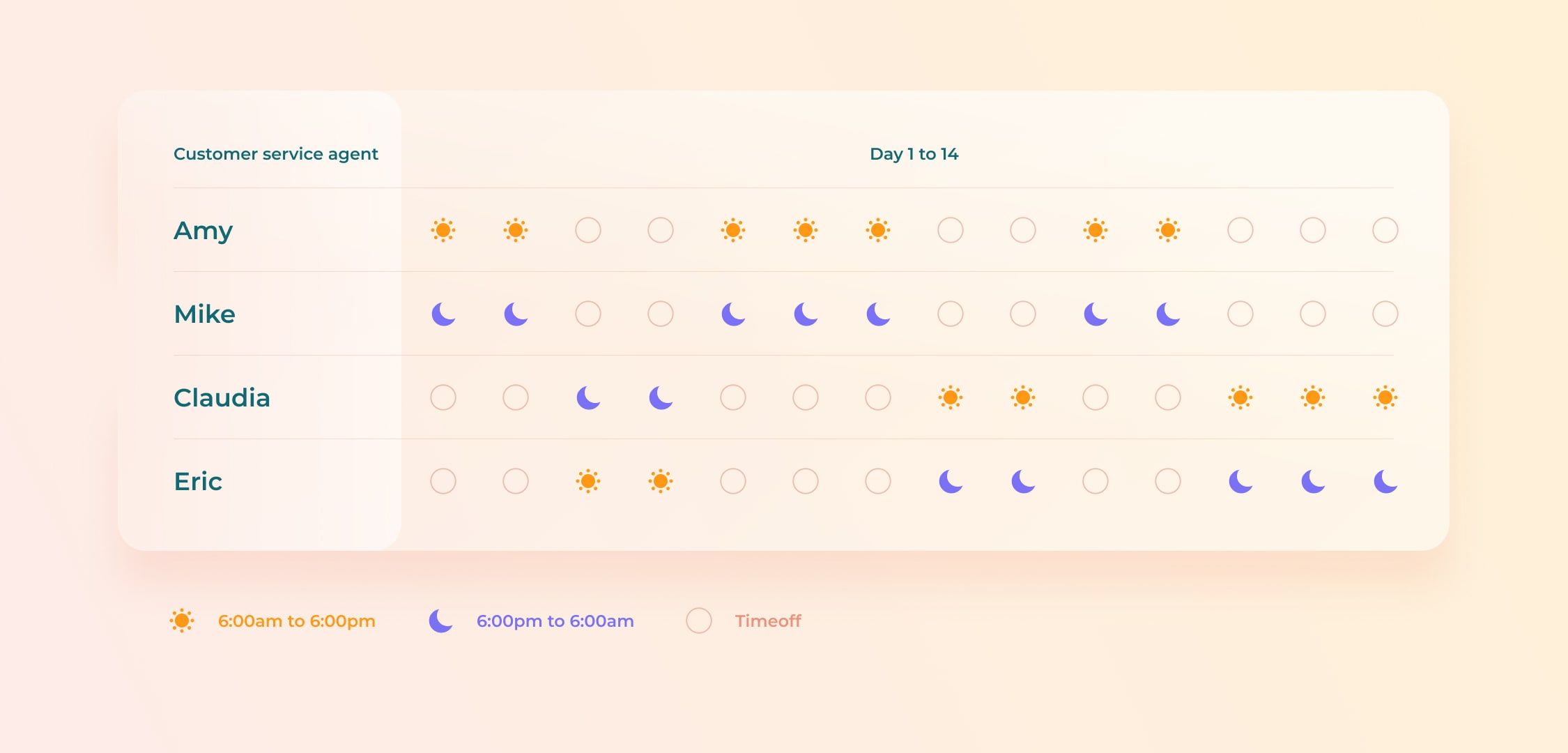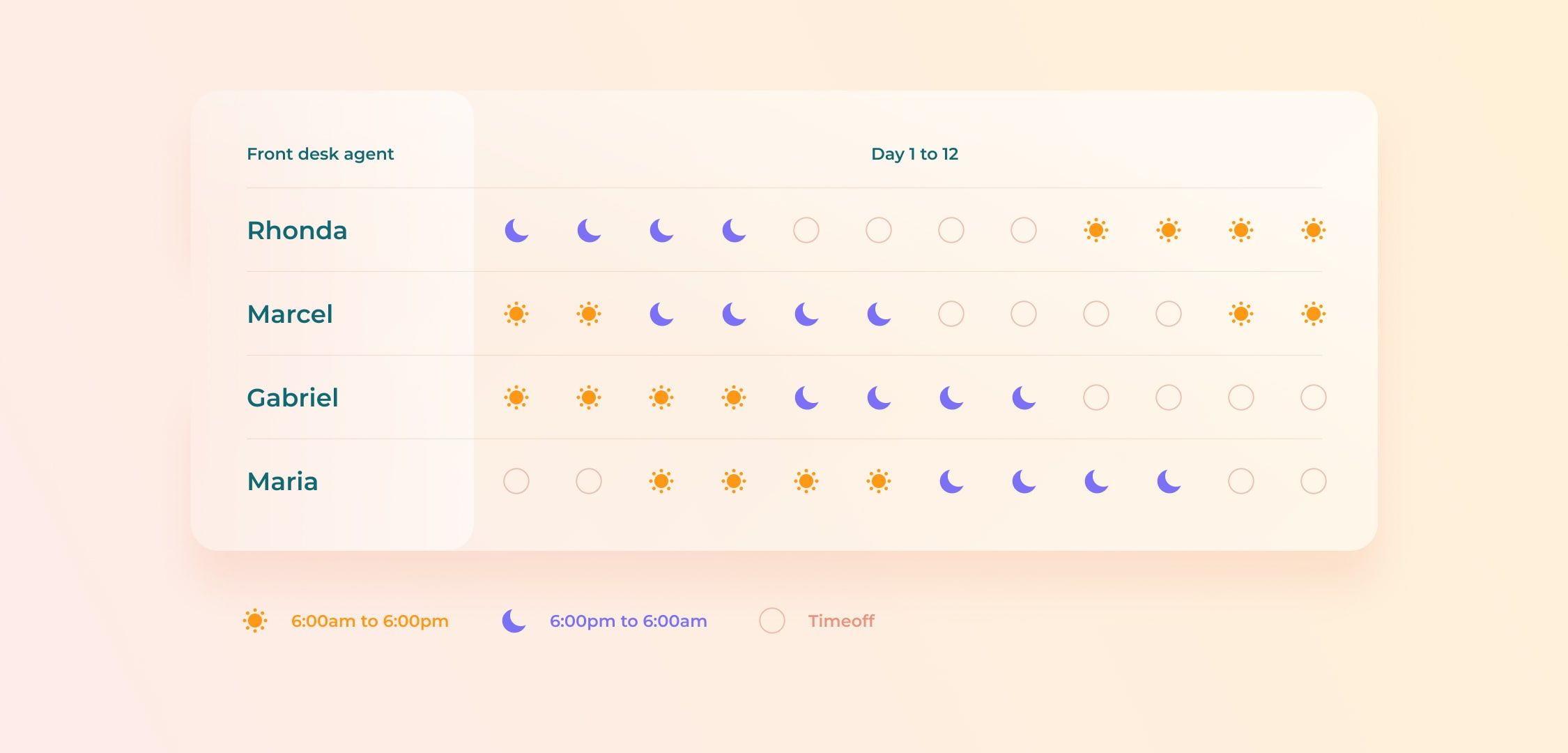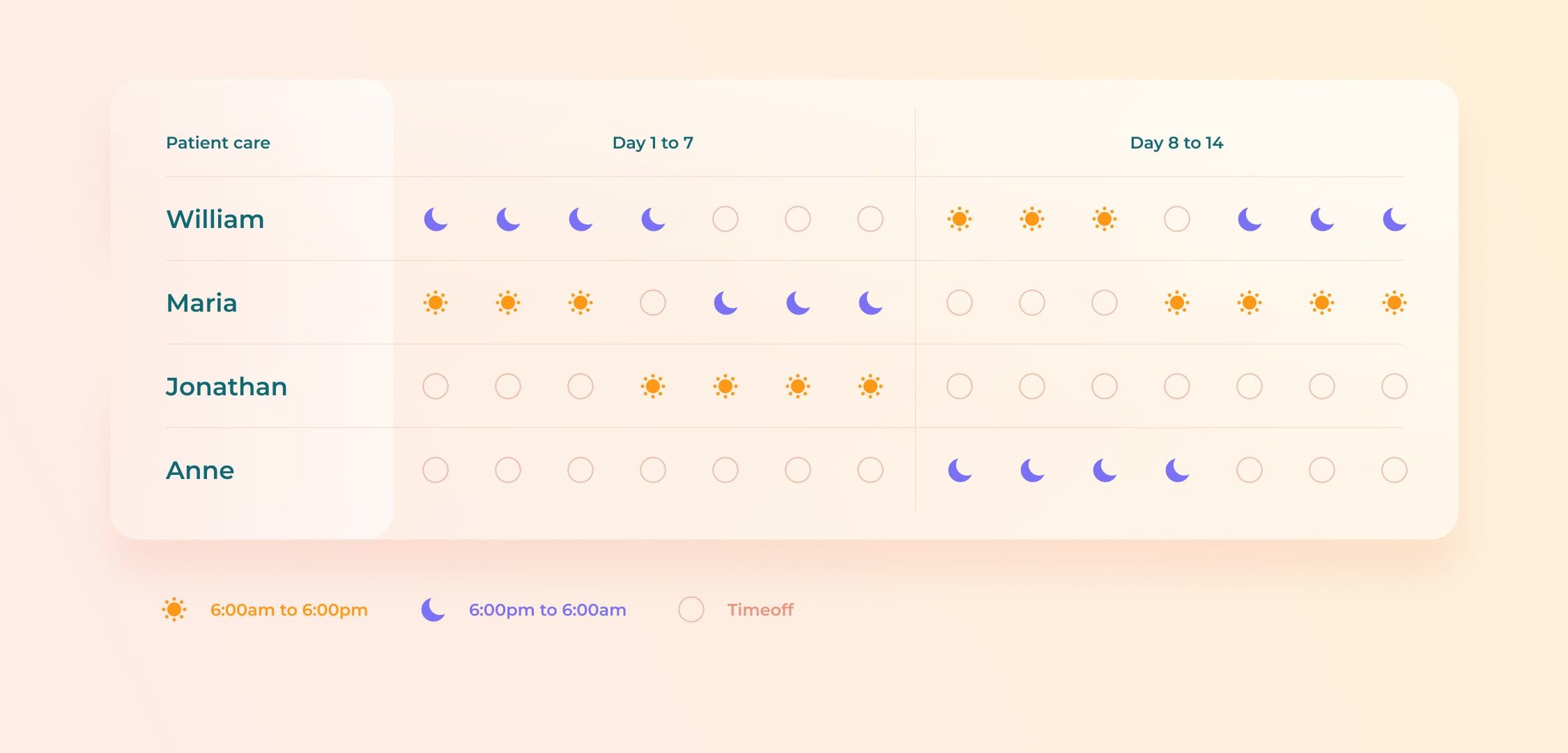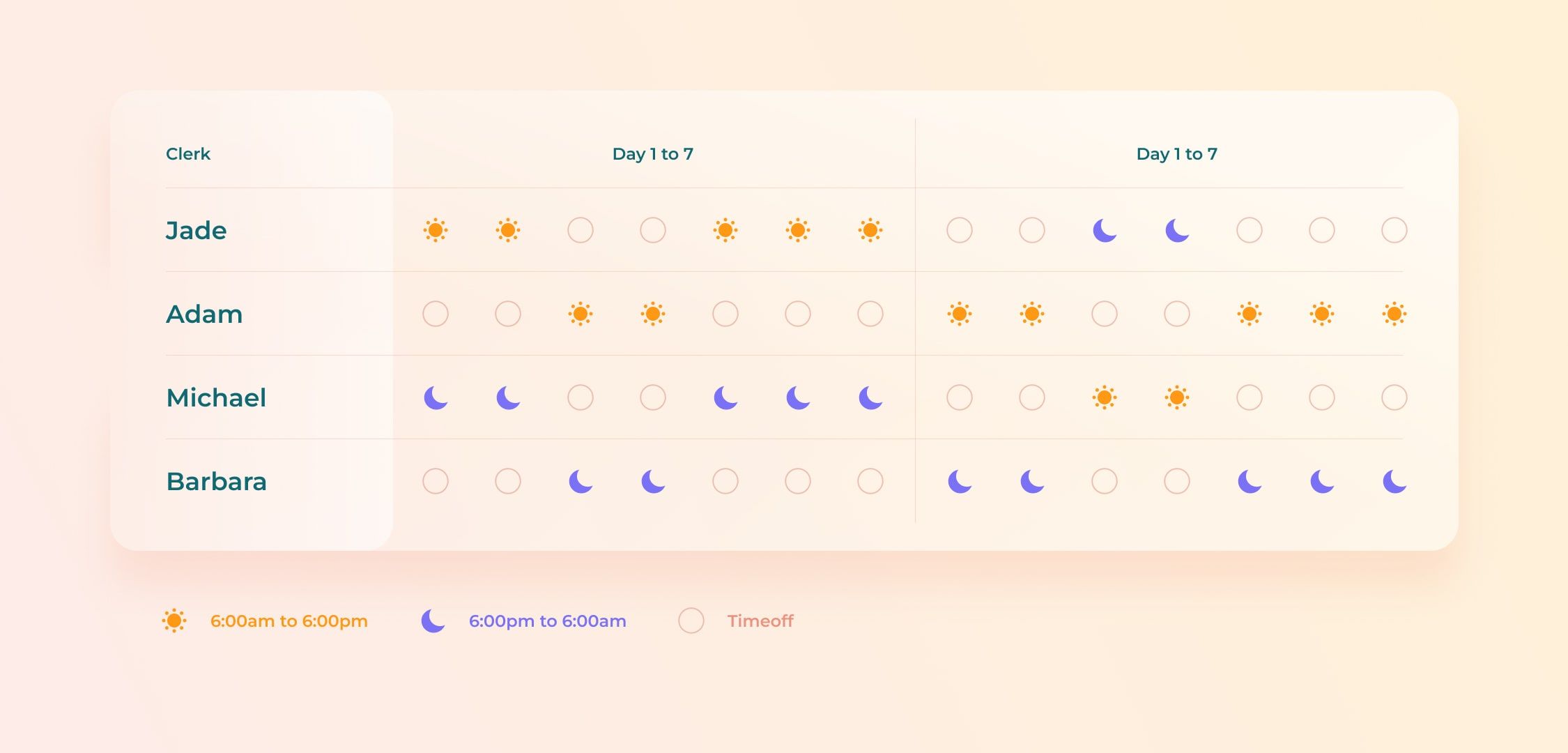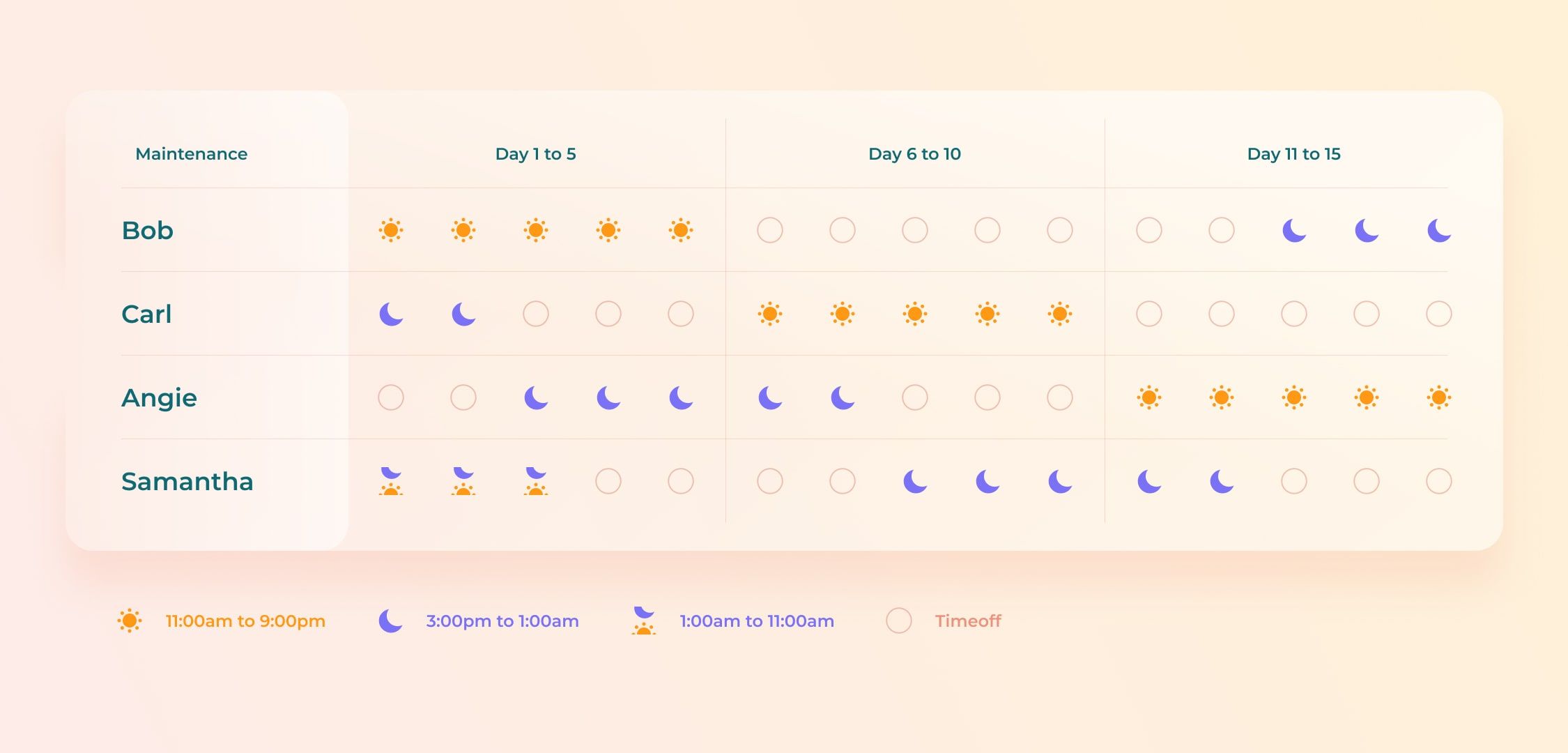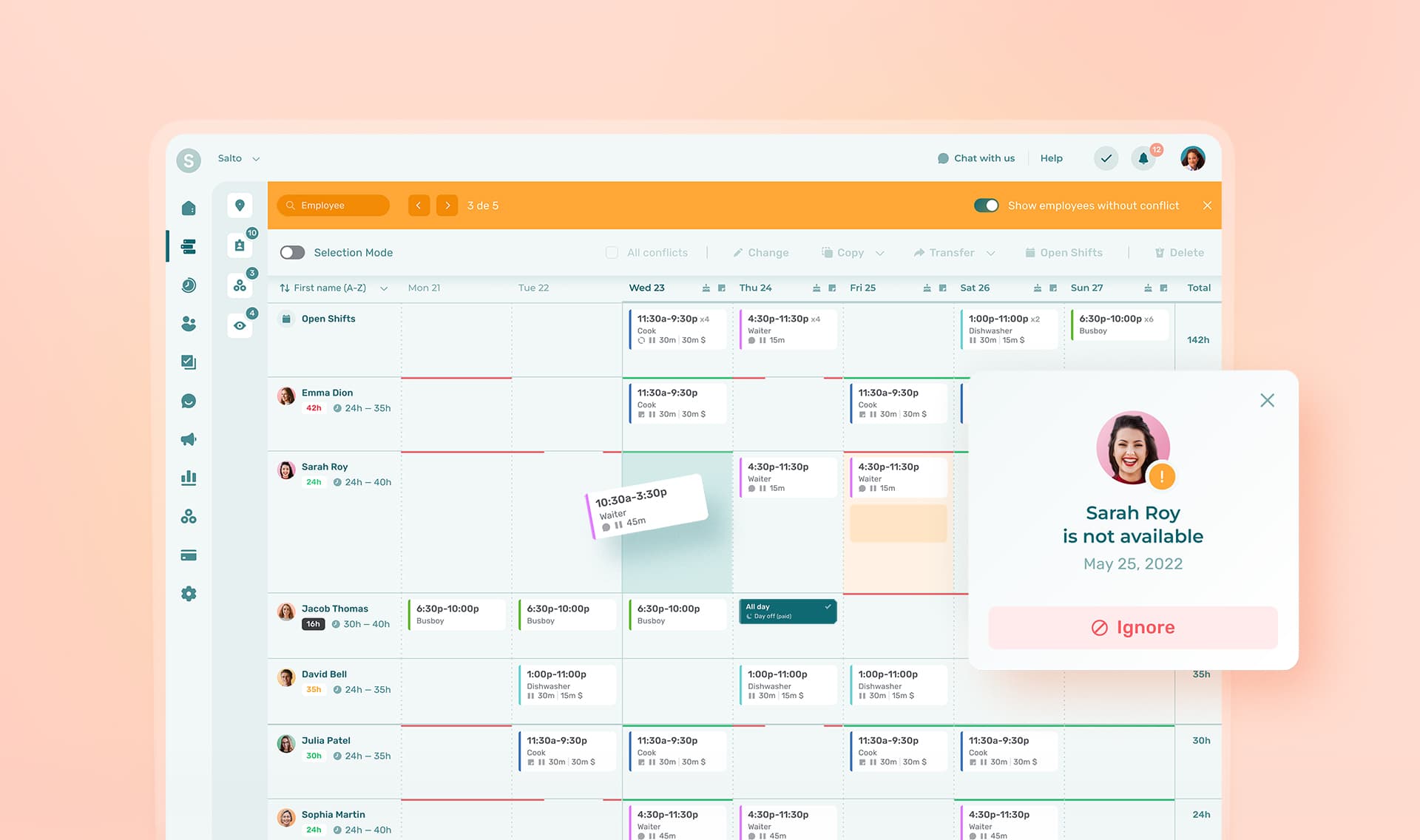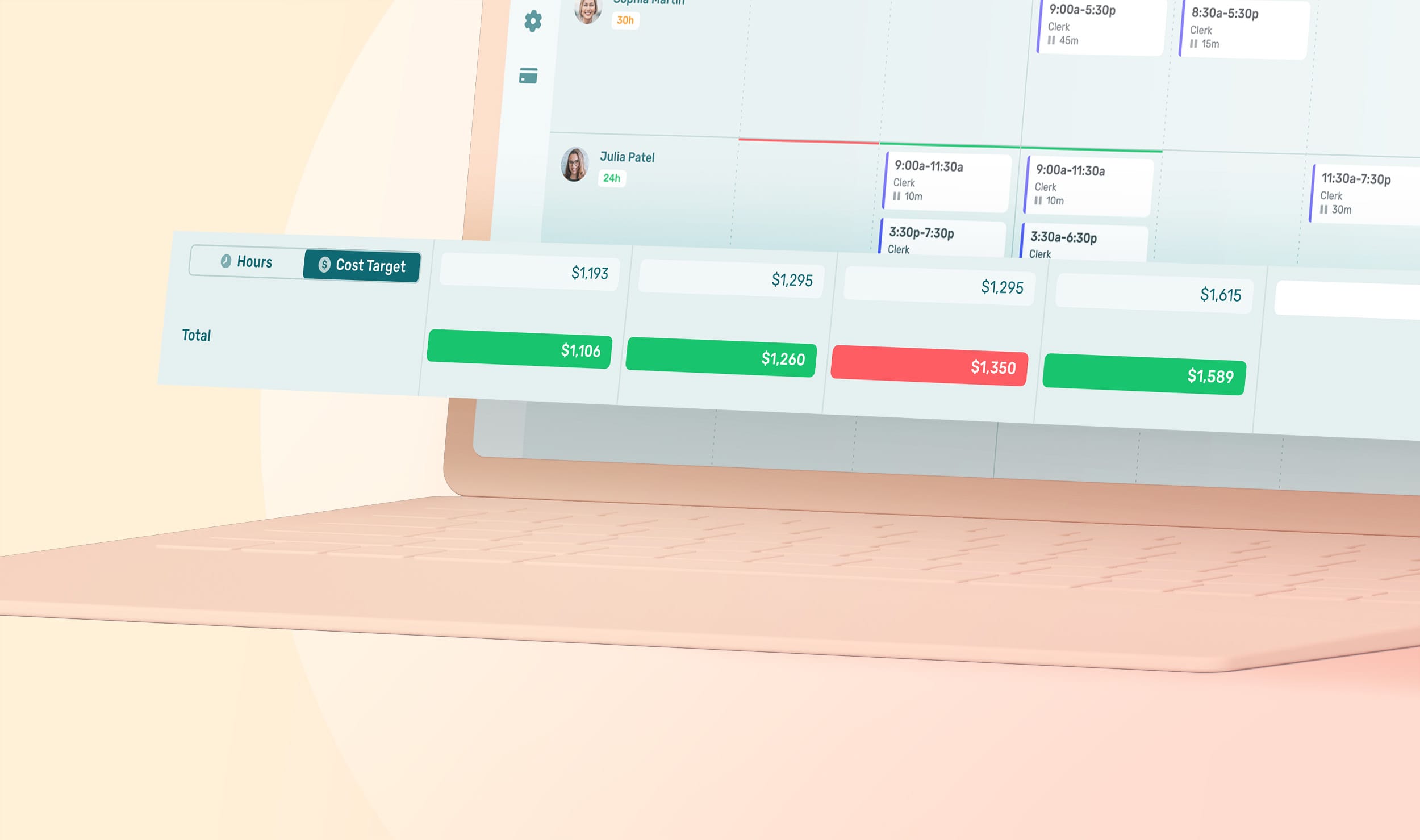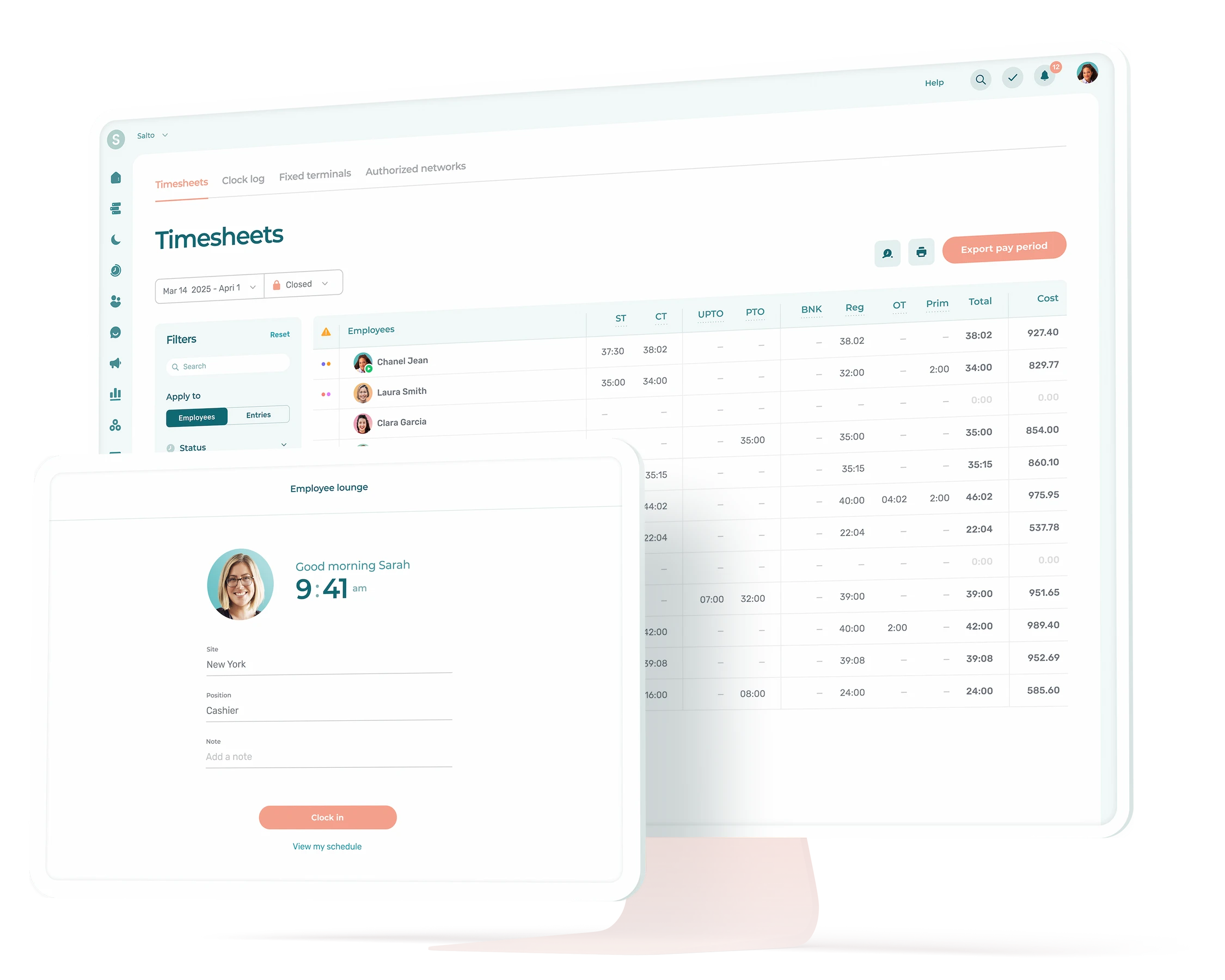Need to schedule employees to work the third shift? Here’s everything you need to know about scheduling night shifts, including the most common types of night shifts and best practices for creating a night shift work schedule. See which night shift is best for your business and employees.
What Is a Night Shift?
A night shift (also known as the graveyard shift or the third shift) is a work shift that takes place during the night hours. Night shifts are common in businesses that operate 24/7, such as in the manufacturing, security and healthcare sectors. The typical night shift runs from 11 pm to 7 am, though exact hours and night shift schedules can vary.
Working the night shift can be hard on the body and mind. As a result, it is often the least popular among shift workers. And many businesses pay premium wages for working the night shift.
Advantages of Working the Night Shift
There are several reasons why employees may prefer to work the night shift.
1. Better Pay
Many businesses pay shift workers a premium for working the night shift. This premium can be calculated as a percentage (typically between 5 and 15 percent per hour) or as a flat amount (typically between 50 cents and $1.25 per hour, or $10 per shift). These amounts can vary from one business to the next.
2. Fewer Distractions
For many businesses, such as offices and hospitality, the bulk of visitors and phone calls occur during the day hours. For employees who like to focus on the task at hand, there will be much less commotion to distract them.
3. Better Camaraderie
Night shifts often have a more relaxed atmosphere than day shifts, which means workers have a little more time to chit-chat and form friendships.
4. Less Competition
Since fewer people want to work the night shift, those that do may find it easier to pick and choose the company they work for. Competing against a smaller talent pool may also mean more opportunity to shine and advance.
Agreeing to work the night shift can also be a great way to get your foot in the door at a company you want to work with, but that currently doesn’t have any job openings during the first and second shifts.
5. Shorter Commute Time
Commuting to and from work while everyone else is at home means less traffic to eat into your personal time.
6. Parenting-Friendly Options
Childcare is expensive for many families. Having one parent work during the day and the other at night means there’s always a parent at home to care for the kids.
Benefits of a Night Shift for the Business
There are many reasons why businesses may want to operate a night shift.
1. Greater Productivity
Extending business hours to 24 hours a day means simply more hours to get more work done.
2. Less Strain on First and Second Shift Employees
If your current team is already clocking too many overtime hours, adding a third shift and expanding your workforce will lighten their workload and lower the risk of employee burnout.
3. Extended Customer Service Hours
24/7 business hours means you can serve customers whenever it’s convenient for them. It also lets you serve global clientele, regardless of time zone.
4. Larger Pool of Potential Employees
Not all shift workers want to work nights. But some do—such as night owls or adults continuing their education during the day.
5. Less Crime
Having employees physically present 24 hours a day can deter would-be thieves, who tend to prefer targets that are dark and empty.
Drawbacks of Working the Night Shift
Working the night shift can be challenging for workers for a number of reasons.
1. Higher Risk of Sleeping Disorders
Our bodies aren’t naturally wired to sleep soundly during the day. Getting good-quality sleep for eight hours when everyone is up and active can be difficult. The daytime light and heat can make it even harder.
Sleep can be especially challenging for employees who switch between the first, second and third shift on a rotating shift schedule.
2. Higher Chance of Health Risks
Altering the body’s natural pattern of resting at night can leave us feeling exhausted and moody. Not getting enough rest can lead to excessive sleepiness, which in turn can make coping with work-related stress a challenge, leading to absenteeism.
3. Higher Risk of Workplace Injury
According to research from the Institution of Occupational Safety and Health, night shift workers are 25 to 30% more likely to be injured than day shift workers.
4. Higher Risk of Strained Relationships
Working nights and not having a regular schedule isn’t easy on home life. It can be tough to spend quality time with friends and family members if you’re always asleep when they’re ready to socialize. Reduced social interaction is also associated with poor mental health.
5. Higher Risk of Being Bored
Less activity at night can be a blessing for shift workers who enjoy peace and quiet. Or it can make for an extremely long and boring work shift for people who enjoy lots of hustle and bustle.
Drawbacks of a Night Shifts for the Business
Operating a night shift can be challenging for businesses for a number of reasons.
1. Additional HR Tasks
Adding a third shift to your daily operations means managing a larger workforce and therefore, more demand on human resources:
- More employee recruiting and hiring
- More employee onboarding and training
- More scheduling problems
- More staff management tasks
2. Higher Payroll Costs
A larger workforce also means higher payroll costs, although the extra productivity should more than compensate for these extra costs.
3. Poor Employee Morale
This can occur if you regularly force employees to work the night shift when they’d rather not.
4. Poor Employee Performance
Some retailers and manufacturing facilities may have fewer or less less-skilled supervisors and managers working during the night shifts, which can lead to lower employee performance and productivity.
5. Higher Risk of Work-Related Accidents
Night shift workers are at a higher risk of having workplace accidents and work-related injuries. Studies have found that police officers who work the night shift are two to three times more likely to suffer long-term injuries than officers working day and evening shifts.
6. Higher Risk of Employee Absence
Poor employee attendance can be a problem if you make working night shifts mandatory for employees.
Which Professions Are Night Shifts Best Suited For?
Many professions have a night shift. Examples include:
- Fast food attendants in the restaurant industry
- Front desk clerks in hospitality
- Sales associate in retail
- Shipping and receiving clerks in the manufacturing industry
- Bus drivers in the public transportation industry
- Security guards in the security industry
- Customer service representatives in call centers
- Professionals in healthcare
- Firefighters, police officers and paramedics in emergency services
- Healthcare givers in the senior living industry
- Highway construction laborers in the construction industry
Types of Night Shift Schedules
1. 2-2-3 Schedule
What Is a 2-2-3 Schedule?
With a 2-2-3 work schedule (also called a Panama schedule), employees:
- Work 12-hour shifts for 2 consecutive shifts
- Get 2 days off
- Work 12-hour shifts for 3 consecutive shifts
- Repeat pattern
Pros:
- Employees get 180 days off per year, giving them a good work-life balance.
- Employees get a regular break from working the night shift, reducing their risk of burnout.
Cons:
- This shift pattern takes some getting used to at first.
- Work shifts are 12 hours long, which can be exhausting for some employees.
2. 4-on 4-off Schedule
What Is a 4-on 4-off Schedule?
With a 4-on 4-off shift pattern, employees:
- Work 12-hour shifts for 4 days
- Get 4 days off
- Work 12-hour shifts for 4 nights
- Get 4 nights off
- Repeat
Pros:
- Good for industries requiring 24/7 365 shift coverage, like hospitality, manufacturing and healthcare.
- Employees get four days off in a row, giving them a good work-life balance.
Cons:
- Working four consecutive 12-hour shifts can be exhausting for some employees.
- Employees need to work on weekends.
- There’s little flexibility on when employees can request time off.
3. DuPont Shift Schedule
What Is a Dupont Schedule?
With a Dupont shift schedule, teams work 42 hours a week over a 28-day cycle. For example:
- Work 4 nights
- Get 3 days off
- Work 3 days
- Get 1 day off
- Work 3 nights
- Get 3 days off
- Work 4 days
- Get 7 days off
Pros:
- Employees get 7 days off each cycle, letting them take week-long vacations regularly if desired, without having to use paid vacation days.
- Ensures 24/7, 365 shift coverage.
Cons:
- Employees get few breaks during the 28-day shift cycle, which can be exhausting for some and lead to employee burnout.
- Employees often need to work weekends.
4. Pitman (2-3-2) Schedule
What Is a Pitman (2-3-2) Schedule?
With a Pitman schedule (also called a 2-3-2 shift schedule), teams work 42 hours a week over a four-week cycle:
- Work 12 hours for 2 consecutive shifts
- Get 2 days off
- Work 12 hours for 3 consecutive shifts
- Get 2 days off
- Work 12 hours for 2 consecutive shifts
- Get 3 days off
- And so on for four-weeks, and then the pattern restarts
Pros:
- Employees get regular time off, which reduces the risk of exhaustion and burnout.
- Ensures 24/7, 365 shift coverage.
Cons:
- Some parts of the cycle can be more tiring than others for employees.
5. 5-5-4 Shift Rotation
What Is a 5-5-4 Shift Rotation?
With A 5-5-4 shift rotation schedule, employees go through a 25-day work cycle as follows:
- Work 10 hours for 5 consecutive shifts
- Get 3 days off
- Work 10 hours for 5 consecutive shifts
- Get 4 days off
- Work 10 hours for 5 consecutive shifts
- Get 3 days off
- Repeats
Pros:
- Employees get regular time off and long weekends, which can increase employee morale and productivity.
- No 12-hour shifts, making multi-day consecutive shifts less exhausting.
- In some areas, employees may be eligible for full-time benefits rather than just being shift workers.
Cons:
- Work shifts switch between first, second and third shifts, making it hard for employees to have a regular work-life schedule.
- Working 5 consecutive 10-hour shifts can be exhausting for some employees.
Shift work disorder (or shift work sleep disorder) commonly affects those who work non-traditional hours outside the usual 9 to 5 work day.
Night Shifts and Employee Rights
Labor laws guarantee night shift workers certain rights. For example:
In Canada, federal law entitles employees to an unpaid 30-minute break during every period of five consecutive hours of work. Businesses that ask employees to work during this break have to compensate them for it.
In the U.S., federal law does not require businesses to give lunch or coffee breaks, but if businesses choose to do so, breaks up to 20 minutes are considered compensable work hours. Longer breaks are not considered compensable work hours.
Labor laws differ by province or state and are constantly being updated. It’s important to regularly consult your local labor laws to ensure the compliance of your business.
Night Shift Scheduling: 6 Best Practices
1. Minimize Consecutive Number of Nights Worked
According to a study from 2020, the best way to minimize the risks associated with working night shifts is to schedule shorter night shifts, have employees work fewer consecutive days, and leave sufficient intervals between shifts.
Use Agendrix scheduling software to create custom rules around shift planning.
Set a minimum number of hours between shifts so that employees don’t work too many hours, too close together. Get alerted if this threshold is not met. Give employees multiple ways to clock, track time & attendance across multiple job sites.
2. Avoid “Extreme” Starting Hours for Shifts
If your chosen work schedule pattern has employees switching between day and night shifts within the same week, avoid starting morning shifts before 6 am., or night shifts after 12 am, This can be extremely hard on the body and make it challenging for employees to develop a consistent and restorative sleep cycle.
Use the work schedule templates in Agendrix scheduling software to create accurate and recurring night shift schedules.
Choose the type of night shift schedule that works best for your business and teams. Easily adapt it to your needs.
3. Offer Night Shift Premiums
In both the U.S. and Canada, businesses are not required to pay a night shift premium, but many choose to do so to create an incentive for employees.
Whenever possible, avoid forcing employees to work the night shift. This will only create worker resentment and low morale.
Always know you true labor costs with Agendrix scheduling software:
Set different compensation amounts based on a host of criteria: first, second or third shift, overtime pay, seniority, etc. See labor costs by shift, by day, by week, month, quarter, year. Compare labor costs vs. historical costs. Get alerts if employees exceed a certain overtime hours threshold.
Create accurate employee work schedules, track labor costs and easily submit hours for payroll with Agendrix employee scheduling software.
4. Stay In Touch With Employees
Night shift employees don’t always get the same chances to connect with middle and upper management as day shift teams do. This can leave them feeling disconnected and disengaged.
It’s especially important to maintain open lines of communication with night shift workers. Not only to track KPIs like productivity and performance, but also employee engagement and job satisfaction.
Having a dedicated internal employee communication platform that promotes regular, open, regular two-way communication between managers and their day and night shift teams will keep everyone in the loop.
Among other things, managers can use the platform to request feedback from night employees on questions like:
- How well they’re adapting to the night shift schedule
- If the hours and chosen night shift schedule meets their needs
- If there are any skill gaps on the night shift that need to be addressed
- If they have access to the resources they need to effectively do their job and quickly address issues that may arise during their shift
Always stay connected with employees with Agendrix scheduling software.
Set up one-on-one or group chat sessions. Get in touch with your employees easily and at any time without lengthy phone calls. Publish business-wide or specific subgroup level updates. Categorize your postings. Enable employee comments for instant feedback.
5. Use a Forward Rotation Schedule
Adapting to working night shifts is hard. It’s even harder when you’re switching between first, second and third shifts in the same cycle.
A forward rotation schedule eases these transitions by starting the work cycle with morning shifts, followed by evening shifts and finally night shifts. This lets employees slowly adapt to later and later work hours, minimizing the impact on their circadian clock.
By scheduling employees for three fixed shifts, you can help them build a routine and better plan their days off. This will improve both their sense of well-being and work-life balance.
Easily build consistent and accurate work schedules with Agendrix scheduling software.
Create your custom recurring schedule templates and adjust them as needed to your needs—such as for busy periods, etc. Send pulse surveys to ensure employees are satisfied with their work schedule.
6. Simplify Shift Swaps
Just like day shift employees, night shift employees will inevitably need to request time off now and again—or urgently need a last-minute shift swap.
Consider automating shift swaps to make it easier to find qualified replacement when needed, whether the shift trade is planned two weeks in advance or 2 hours before the shift is scheduled to start.
Eliminate the stress and guesswork of shift swaps with Agendrix scheduling software.
Keep everyone who needs to be in the loop informed. Set a host of parameters for how shift trades are requested, approved and communicated, as well as the criteria for an acceptable “match” (skill set, hours worked, seniority, etc.)
Health & Safety Tips for Night Shift Workers
Managers and business owners can share some of the following tips to help employees prepare for their first night shift and prevent prolonged sleep deprivation.
1. Adjust Your Sleep Schedule in Advance
Before you start working night shifts, start gradually moving the time you go to bed later by one or two hours until your sleep schedule is aligned with your night shift schedule.
2. Consume Caffeine in Moderation
Moderate amounts of caffeine can increase alertness. Excess amounts can affect sleep and actually make you more tired. If you choose to drink tea, coffee or caffeine-rich beverages, drink them closer to the start of your shift. Avoid consuming too much caffeine near the end of your shift as they can make it more difficult to fall asleep.
3. Power Nap When Possible
Sleep deprivation can lower productivity at work. If you are allowed scheduled breaks during your night shift, consider taking 20 or 30-minute power naps. Any longer will put you into a deeper sleep mode from which it’s much harder to wake up without feeling drowsy.
Businesses can also help keep night employees alert by installing bright lights and implementing mandatory breaks.
4. Eat Smaller Portions More Often
Rather than eating one large, heavy meal during your night shift, having several small snacks will make it easier to remain alert.
5. Avoid Bright Light on Your Way Home
Light exposure—especially the morning sunlight—tells our brains it’s time to wake up. If the sun is up when you’re on your way home from your night shift, wear dark sunglasses. Avoid looking at blue lights like TVs and smartphones, which can make it harder to fall asleep.
Conclusion
The best shift schedule for your business will depend on your productivity needs, industry and the size of your team. Consider the different types of night shift schedules carefully and keep the well-being of your team in mind.
Keep the lines of communication open with your night shift teams. This employee feedback will be vital to job satisfaction and employee retention.
And if you want to streamline the entire process of scheduling employees, book a free demo of Agendrix employee scheduling software. It comes with a variety of night shift schedule templates that you can easily adapt to create recurring work schedules for your teams, automate shift swaps, and facilitate time-off requests.
What Is the Best Schedule for Night Shift Workers?
There is no single best schedule. The best night shift schedule for your business will depend on your productivity needs, industry and the size of your team.
The most common night shift schedules are:
- 2-2-3 shift schedule (Panama schedule)
- 4-on 4-off shift schedule
- DuPont shift schedule
- 2-3-2 shift schedule (Pitman schedule)
- 5-5-4 shift schedule
How Long Should You Sleep If You Work a Night Shift?
Most healthy night shift workers still need the recommended 7-9 hours of sleep.
A healthy 24-hour schedule for a night shift worker whose shift begins at 11 pm might look something like this:
- 11 pm: Start of night shift.
- Midnight to 5 am: Simulate daytime. Ask your employer to install bright lights or invest in a light-therapy box to reset your body clock and remain alert.
- 3 am: Last call for coffee. The half-life of caffeine is around four to six hours on average; consuming too much near the end of your night shift can interfere with your sleep.
- 3 to 4 am: Eat dinner. If you’re still hungry, eat light snacks later on during the shift.
- 7 am: Head home. Avoid light as much as possible until you get into bed. Wear dark sunglasses and avoid “blue light” screens to avoid triggering alertness.
- 8 am to 3 pm: Sleep. Keep your bedroom as dark and quiet as possible. If needed, invest in blackout curtains and a white noise machine.
- 3 to 4 pm: Get up and have breakfast. Get at least 15 minutes of direct sun exposure. This will trick your circadian clock into thinking it’s morning.
- 4:30 to 11 pm: Enjoy your daily activities. Spend time with family, do household chores, exercise, etc.
- 9 pm: Eat lunch.






